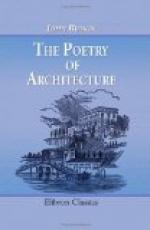12. With these feelings, we shall devote some time to the consideration of the prevailing character, and national peculiarities, of European cottages. The principal thing worthy of observation in the lowland cottage of England is its finished neatness. The thatch is firmly pegged down, and mathematically leveled at the edges; and, though the martin is permitted to attach his humble domicile, in undisturbed security, to the eaves, he may be considered as enhancing the effect of the cottage, by increasing its usefulness, and making it contribute to the comfort of more beings than one. The whitewash is stainless, and its rough surface catches a side light as brightly as a front one: the luxuriant rose is trained gracefully over the window; and the gleaming lattice, divided not into heavy squares, but into small pointed diamonds, is thrown half open, as is just discovered by its glance among the green leaves of the sweetbrier, to admit the breeze, that, as it passes over the flowers, becomes full of their fragrance. The light wooden porch breaks the flat of the cottage face by its projection; and a branch or two of wandering honeysuckle spread over the low hatch. A few square feet of garden and a latched wicket, persuading the weary and dusty pedestrian, with expressive eloquence, to lean upon it for an instant and request a drink of water or milk, complete a picture, which, if it be far enough from London to be unspoiled by town sophistications, is a very perfect thing in its way.[1] The ideas it awakens are agreeable, and the architecture is all that we want in such a situation. It is pretty and appropriate; and if it boasted of any other perfection, it would be at the expense of its propriety.
[Footnote 1: Compare Lectures on Architecture and Painting, I. Sec. 16.]
13. Let us now cross the Channel, and endeavor to find a country cottage on the other side, if we can; for it is a difficult matter. There are many villages; but such a thing as an isolated cottage is extremely rare. Let us try one or two of the green valleys among the chalk eminences which sweep from Abbeville to Rouen. Here is a cottage at last, and a picturesque one, which is more than we could say for the English domicile. What then is the difference? There is a general air of nonchalance about the French peasant’s habitation, which is aided by a perfect want of everything like neatness; and rendered more conspicuous by some points about the building which have a look of neglected beauty, and obliterated ornament. Half of the whitewash is worn off, and the other half colored by various mosses and wandering lichens, which have been permitted to vegetate upon it, and which, though beautiful, constitute a kind of beauty from which the ideas of age and decay are inseparable. The tall roof of the garret window stands fantastically out; and underneath it, where, in England, we had a plain double lattice, is a deep recess, flatly arched




